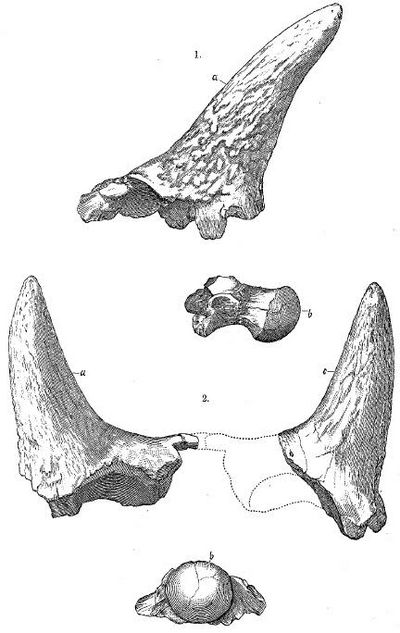Ceratops: Różnice pomiędzy wersjami
m (dzięki szerman za aktualizację :)) |
(wiek) |
||
| Linia 4: | Linia 4: | ||
| Autor: | | Autor: | ||
|- | |- | ||
| − | | [[Maciej Ziegler]], [[ | + | | [[Maciej Ziegler]], [[Marcin Szermański]] |
|} | |} | ||
</small> | </small> | ||
| Linia 27: | Linia 27: | ||
|- | |- | ||
! '''[[Czas|Czas występowania]]''' | ! '''[[Czas|Czas występowania]]''' | ||
| − | | | + | | 79-74<ref>Ryc. 6.11 w Roberts, E.M., Sampson, S.D., Deino, A.L., Bowring, S.A. & Buchwaldt, R. (2013) "The Kaiparowits Formation: A Remarkable Record of Late Cretaceous Terrestrial Environments, Ecosystems, and Evolution in Western North America" [w]: Titus, A.L. & Loewen, M.A. (red.) "At the Top of the Grand Staircase: The Late Cretaceous of Southern Utah" Bloomington, Indiana University Press, 85-106.</ref> [[Ma]] |
<small>[[późna kreda]] ([[kampan]])</small> | <small>[[późna kreda]] ([[kampan]])</small> | ||
| Linia 112: | Linia 112: | ||
Marsh, O.C. (1888) "A new family of horned Dinosauria, from the Cretaceous" American Journal of Science, 36(3), 477-478. | Marsh, O.C. (1888) "A new family of horned Dinosauria, from the Cretaceous" American Journal of Science, 36(3), 477-478. | ||
| − | Sereno, P. (2005/w druku): http://www.taxonsearch.org/dev/taxon_edit.php?Action=View&tax_id=82</small> | + | Sereno, P. (2005/w druku): http://www.taxonsearch.org/dev/taxon_edit.php?Action=View&tax_id=82 |
| + | |||
| + | <references/> | ||
| + | </small> | ||
[[Kategoria:Dinosauria]] | [[Kategoria:Dinosauria]] | ||
Wersja z 22:39, 12 lut 2014
| Autor: |
| Maciej Ziegler, Marcin Szermański |
| Ceratops (ceratops) | |
|---|---|
| Długość: | ? m |
| Masa: | ? t |
| Miejsce występowania: | USA - Montana |
| Czas występowania | 79-74[1] Ma |
| Systematyka | Dinosauria |

| |
Wstęp
Ceratops to nieważny rodzaj ceratopsa z późnej kredy (kampan) USA (formacja Judith River).
Materiał kolalny
Holotyp to rogi zaoczodołowe i kłykieć potyliczny.
Etymologia
Othniel C. Marsh tworząc nowa rodzinę, rodzaj i gatunek nie wyjaśnił pochodzenia nazw, ale zapewne Ceratops to połączenie greckich słów ceras (róg) i ops (twarz). Epitet gatunkowy pochodzi pewnie od miejsca znalezienia - stanu Montana.
Pozycja filogenetyczna i nazewnictwo
Ceratopsa uważa się (np. Dodson i Currie, 1990) za przedstawiciela jednego z dwóch kladów wyróżnianych wśród Ceratopsidae: Chasmosaurinae, zwanego też Ceratopsinae (będącego siostrzanym taksonem Centrosaurinae). Założenie to wynika z dość długich rogów osobnika (Sereno, 2005/w druku). Są one jednak spotykane również u Centrosaurinae (np. Diabloceratops) i bardziej bazalnych ceratopsoidów (Zuniceratops). Za przynależnością do Centrosaurinae opowiada się Longrich (2013). Zauważa on bardzo duże podobieństwo Ceratops do Albertaceratops i Avaceratops w posiadaniu stosunkowo krótkich i zakręconych ku przodowi rogów zaoczodołowych, jak i występowaniu długich rogów nadocznych również u tych centrozaurynów.
Niepewność pozycji filogenetycznej ceratopsa sugeruje więc stosowanie nazwy Chasmosaurinae zamiast Ceratopsinae. Uzasadniony mógłby być też powrót do Agathaumidae (Cope, 1889) i utworzenie Agathauminae w miejsce Chasmosaurinae.
Spis gatunków
| Ceratops | Marsh, 1888 | nomen dubium |
| C. montanus | Marsh, 1888 | nomen dubium |
| C. alticornis | (Marsh, 1889) Marsh, 1887 | = "Bison" alticornis |
| C. belli | (Lambe, 1902) Hatcher, Marsh i Lull, 1907 | = Chasmosaurus belli |
| C. canadensis | (Lambe, 1902) Hatcher, Marsh i Lull, 1907 | = Eoceratops canadensis |
| C. horridus | Marsh, 1889 | = Triceratops horridus |
| C. paucidens | (Marsh, 1890) Marsh, 1889 | = Hadrosaurus paucidens |
| C. recurvicornis | (Cope, 1889) Hatcher vide Stanton i Hatcher, 1905 | = Monoclonius recurvicornis |
Bibliografia
Dodson, P., Forster, C.A. & Sampson, S.D (2004) "Ceratopsidae" [w:] Weishampel, D.B., Dodson, P. & Osmólska, H. "The Dinosauria" Berkeley and Los Angeles: University of California Press, 494-513.
Dodson, P. & Currie, P.J. (1990) "Neoceratopsia" [w:] Weishampel, D. B., P. Dodson, & H. Osmólska (ed.) "The Dinosauria" University of California Press, Berkeley, 593–618.
Hatcher, J.B., Marsh, O.C., & Lull, R.S. (1907) "The Ceratopsia" US Geological Survey Monograph, 49, 1-300.
Longrich, N.R. (2013) "Judiceratops tigris, a New Horned Dinosaur from the Middle Campanian Judith River Formation of Montana". Bulletin of the Peabody Museum of Natural History 54: 51–65. doi:10.3374/014.054.0103
Marsh, O.C. (1888) "A new family of horned Dinosauria, from the Cretaceous" American Journal of Science, 36(3), 477-478.
Sereno, P. (2005/w druku): http://www.taxonsearch.org/dev/taxon_edit.php?Action=View&tax_id=82
- ↑ Ryc. 6.11 w Roberts, E.M., Sampson, S.D., Deino, A.L., Bowring, S.A. & Buchwaldt, R. (2013) "The Kaiparowits Formation: A Remarkable Record of Late Cretaceous Terrestrial Environments, Ecosystems, and Evolution in Western North America" [w]: Titus, A.L. & Loewen, M.A. (red.) "At the Top of the Grand Staircase: The Late Cretaceous of Southern Utah" Bloomington, Indiana University Press, 85-106.